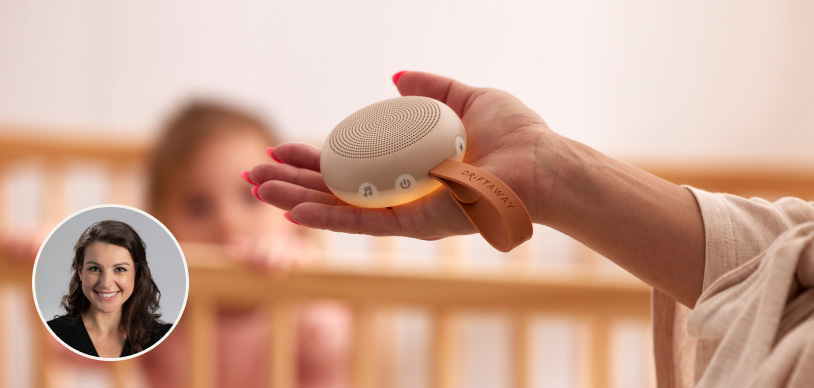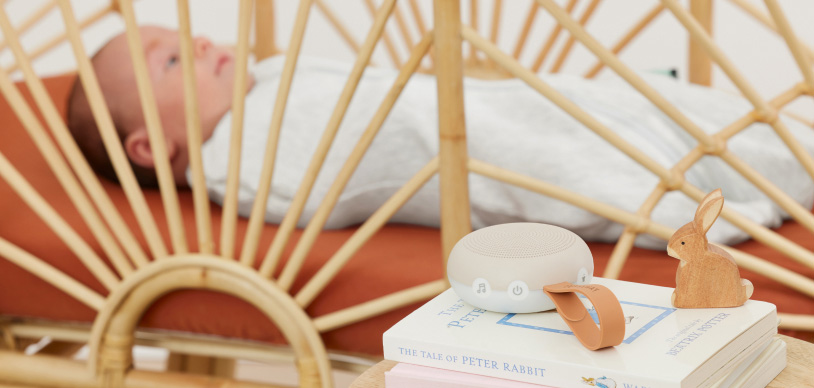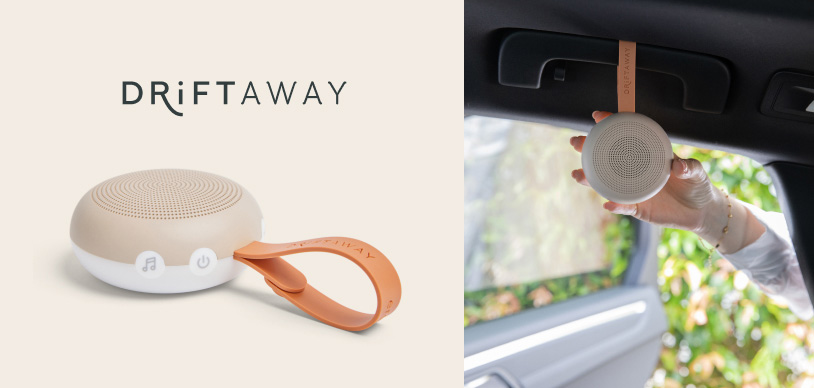
In this conversation, we speak with Jane Wiggill to discuss all things White noise. Jane is a registered nurse and midwife and has spent over 13 years working in birthing suites across the state of Victoria.
More recently, as Chief Midwife of Red Nose Australia, she was the advocate, lead developer and keeper of Red Nose's evidence-based health expertise. She currently works as a senior midwife at Mercy Health and consults to various industry groups with a strong focus on infant and child health and safety.
What is white noise and why is it so popular for sleep?
White noise refers to a noise that contains lots of frequencies across the spectrum of sound, all in equal measure. It's produced when we combine lots of different frequencies together so that not one sound specifically is heard clearly or distinct from one another. What you end up with is this beautiful, fuzzy kind of sound that has no specific pitch, but blends out what is happening in our outside environment, and so things like doors slamming, loud conversations and dogs barking suddenly become softened by this beautiful nonspecific noise.
How does that help baby sleep in particular? Are they sensitive to those types of noises when they're trying to settle?
In order for babies to quiet and calm themselves down in preparation for sleep, a series of coordinated central motor and cardiac regulations occur for that to happen. For some babies, especially those in that 0-3 month age category, more support is required to help them fall off to sleep.
The support required is similar to what they received in utero, such as having a snug space to sleep in, deep whooshing sounds of the maternal blood flow and movements such as rocking and sucking. We can achieve all of these things on the outside of the womb by holding them, rocking them and shushing them, but we can also use a device like a white noise machine to help create that beautiful environment for babies that they are familiar with. White noise mimics that so beautifully!
From around 17 to 18 weeks gestation, our babies were able to hear the maternal heartbeat. As they grew, these sounds became more sophisticated and layered and, by 27 weeks and beyond, the baby could now hear sounds from outside the womb, such as your voice, the voice of another carer, siblings and animals.
What we need to remember is those sounds were buffered by the maternal body and the amniotic fluid that surrounded the baby, and therefore there was no one loud sound that grabbed their attention; it was received in combination with whooshing and humming sounds, which are beautifully comforting to little babies. When we're preparing our baby for sleep, white noise can provide that baby with that additional support and remind them that it's a safe time; we can settle down now, and we can go to sleep.

Is white noise the magic answer for sleep? Or should it be used in conjunction with other tools when it comes to settling a baby?
It absolutely is something that can be added to your toolkit. Bring it into the sleep routine of having a bath or using a beautiful Swaddle or Sleep Suit on your baby. Turn your white noise machine on, and all those things in combination are really helpful when building that sleep association for your baby.
What are the safety tips parents need to be aware of if they do want to incorporate white noise into their sleep routine?
First and foremost, white noise in and of itself can always be safely introduced to a baby from birth, providing that you follow recommendations that have been well-considered by manufacturers who produce white noise machines or apps. The most important thing with white noise is that we remember that it should only be played in the background, never in the foreground. We don't want to use a sound that is so loud that we're intensely trying to drown out whatever is happening outside, that's not the point, and we could potentially be doing harm to our babies.
When considering noise level, think of a similar level to a conversation, a shower, or a dryer that's being used in the background. When we think about babies volume recommendations, for little babies particularly, where they're still growing and developing all of those systems, comfortable noise levels are between zero and 60 DB. Anything louder than 60 to 90 decibels, such as traffic, heavy trucks with air brakes on the freeway, alarms and jet engines, create horrible noises that are not good for the baby, so we need to make sure that we're keeping our white noise device at a comfortable and safe level.
There are safe sleep principles in place that we need to follow to make sure that our babies stay safe, therefore, we never place anything inside that cot space, particularly anywhere near the head. If we're using a white noise device, we need to make sure that it remains outside of the cot, ideally 2 metres away.
How do we safely use a white noise machine around the pram and in the car when we can't achieve the two metres distance?
If you're in a confined space, just remember that the volume recommendations are adhered to, perhaps we have to turn it down a little bit lower because there isn't a lot of space for that noise to diffuse around those tiny ears that are still developing. Use your safety judgement. Ensure that the baby can't pull the device into the cot, or any other sleep space, that's where a lot of the danger can happen, either accidental injury or further catastrophe.
When is a good time to stop using white noise? What are some of the parameters around that?
The first thing to consider is that our babies are very individual with regards to themselves as little human beings, just as we are as adults, but also their requirements for sleep. It's a very individual decision to be made by the parents and the caregivers. If you'd like to start using white noise from birth, there is absolutely no harm in doing so, in fact, certainly the research that I've found on this very topic all points to positive outcomes with shorter crying times and settled babies. For brand new parents, if you feel that your baby requires the additional support of white noise to help them settle down and sleep, absolutely go for it, and know that you're not doing any harm.
As your baby grows and becomes more aware of their routine and of the world around them, they may work out quickly that this beautiful noise means sleep and potentially resist the white noise as a tool in favour of staying awake for longer. At that point, you might consider taking it away as a sleep tool and seeing how your baby responds without the white noise. By around 12 months of age, most babies consume themselves with the support of a transitional object such as a teddy, and they no longer require the additional support of white noise. If it's still working, you can absolutely keep using it.
If you have incorporated it into your sleep routine and you decide that you want to go on a holiday or you want to go and have dinner at the grandparent's house, and suddenly you're going to be outside of your normal sleep environment, you've got this tool to help remind baby that this is a safe place and we're going to sleep now. You'll have more success and a much more enjoyable experience when you're on the go. When to stop is up to the discretion of the parent and caregiver in conjunction with the baby.
What's your personal experience with white noise as a mother, midwife and shift worker?
I have two children that are unique and individual in their sleep requirements. My first child, who's now 14, loved white noise from the beginning. I, like many first-time parents, was very anxious about making sure that she had enough sleep, I wanted to do the right thing for her. White noise was something I used from the start. You don't want to be sitting there anxious at sleep time and have the baby pick up on that, potentially making settling down more difficult and sleep time a disaster white noise is fantastic for moderating the anxiety around the adult and soothing them, just as much as it is for soothing the baby. I found I could then comfortably go to dinner with my daughter, or we could go away on holiday, and we would bring it with us, and she associated the sound with sleep. When the time came, we stopped using it, and it was a very smooth transition.
Fast forward to the second baby, and it was a completely different experience. White noise for him was a bit of a joke. He used to lie awake and listen to it which defeated the purpose entirely. For him it didn't work, and that was OK because that was him, and we found other ways to convince him to settle down and go to sleep.
As a midwife, it's important to be able to provide the parents and caregivers with something that can potentially reduce their own anxiety, particularly if sleep time is really stressful. If you've got something that you know is going to calm you down, your baby through attunement will absorb that. I certainly have no problems recommending white noise to new parents. When I'm working in theatre and receiving babies born by caesarean section, there is a moment where the mother is separated from her baby. During this time, the second caregiver comes with me into my office where it's nice and dark, and we turn the white noise on. Immediately we're providing white noise to the baby because suddenly they have lost all of that beautiful noise that they're so used to in the womb.
As a shift worker, I can absolutely attest that white noise has been extremely helpful to me to be able to settle myself down and prepare for sleep when I'm coming off night duty and trying to sleep during the day. If I have a bit of anxiety, it stops all of that internal chatter and provides a nice space for me.
Can parents who are expecting bring white noise into the hospital?
They absolutely can bring anything they like with them, so if they want to use it as a tool in labour they can. I think that would be a fantastic thing to do if there are machines in the background that are scary. It's a nice way to blend those things out and normalise the situation. You can certainly use it in the post-natal ward after birth as a quiet tool that's not going to disrupt others on the ward. Remember we are following volume recommendations on these devices, and this is a lovely gentle, conversational undertone to settle everybody off to sleep.
Find out more about the White noise Machine here .